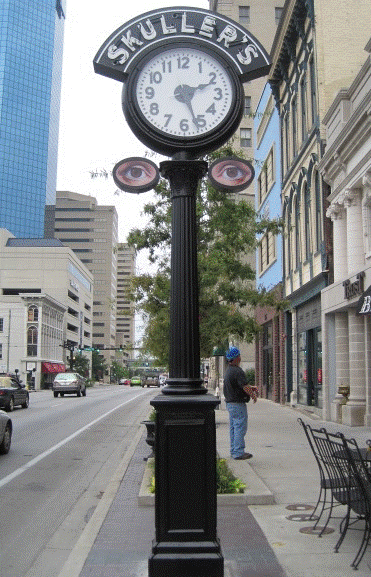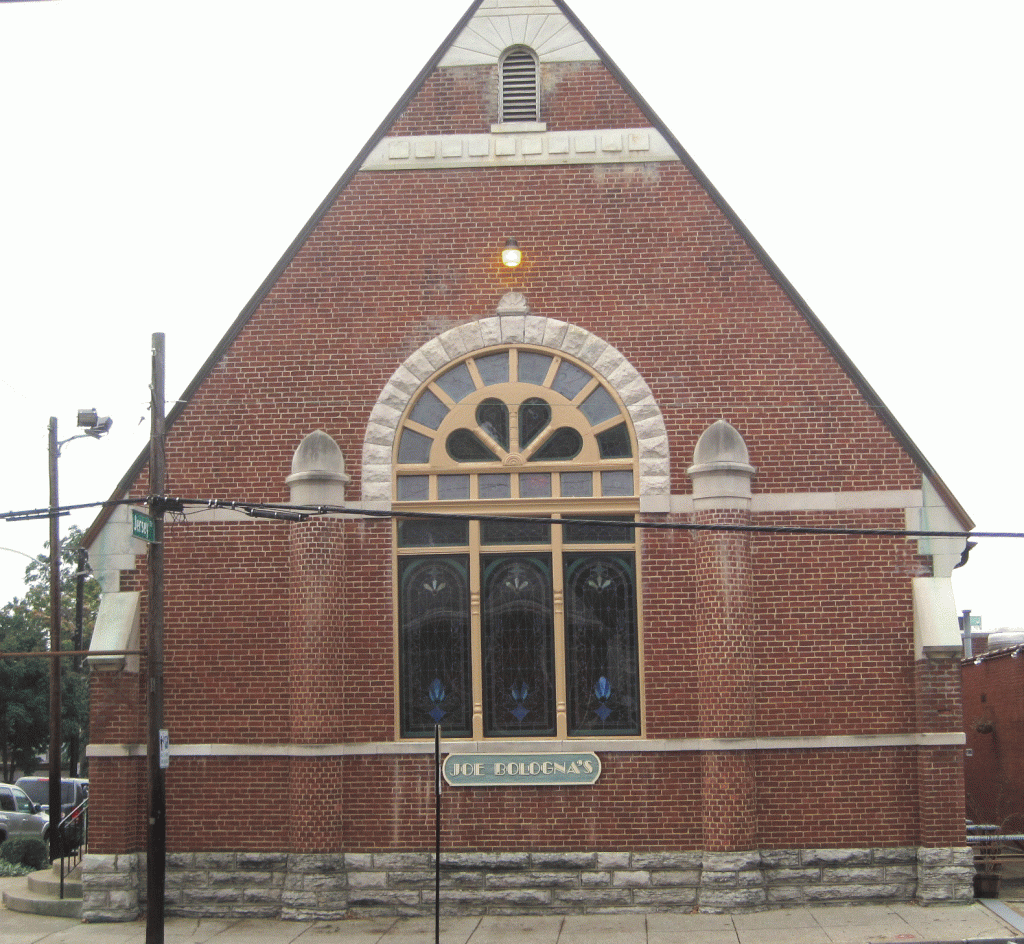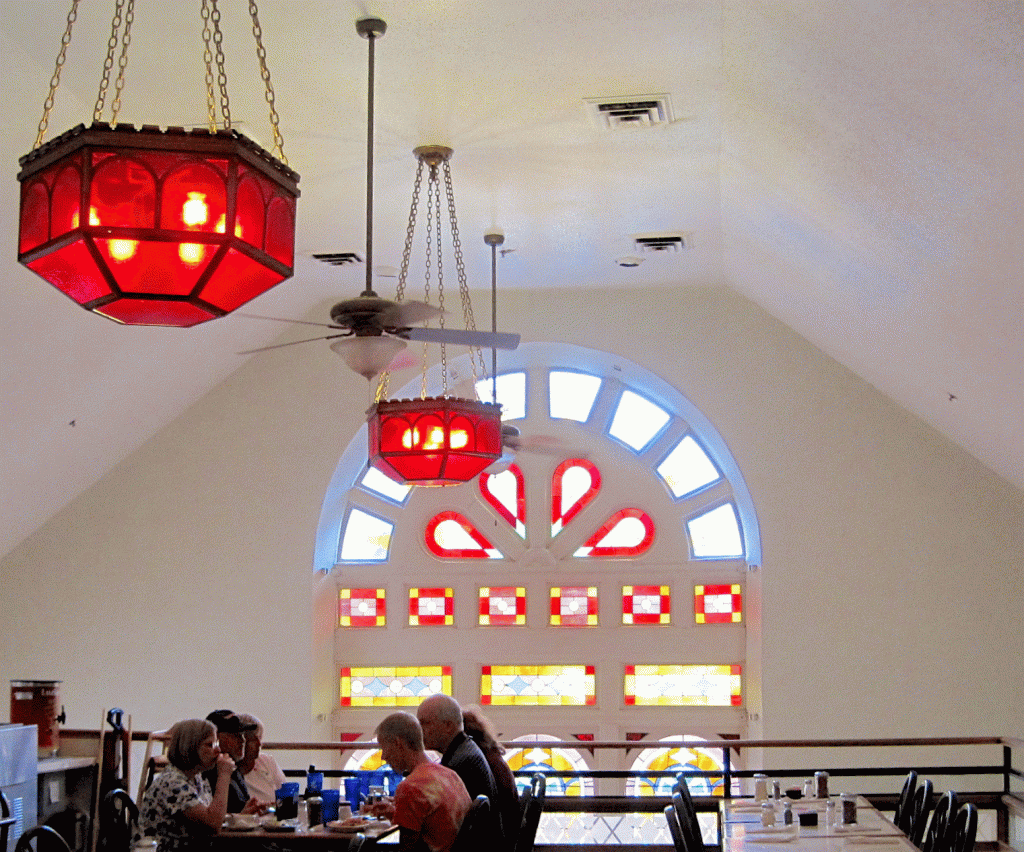BY JANET STEINBERG
Lexington is horses and heritage, mansions and museums, blue grass
and bibelots, and a pizzeria/restaurant housed in what was once the
first Jewish synagogue in Lexington.
Following a 4-hour drive from Lake Tellico in Vonore, Tennessee, we
couldn’t wait to plop down on the inviting four-poster bed
in Lexington’s historic boutique hotel, The Gratz Park Inn.
The Gratz Park Inn exemplifies the Southern grace and charm for which
Lexington is known. Nestled in the heart of
downtown’s historic district, the Inn was built in 1919 as a medical
office. In 1987 it was renovated to become a luxury hotel.
 |
THE HISTORIC GRATZ PARK INN |
Gratz
Park Inn, and the nearby Gratz Park, are named after the late
Benjamin Gratz (1792-1884, a graduate lawyer and the youngest of 12
children born in Philadelphia to Jewish merchant Michael and Miriam
Gratz. He headed a prominent manufacturing business and is
buried, along with his good friend Henry Clay, in the Lexington
Cemetery (833 W. Main).
Gratz’s historic 1806 home (which he purchased in 1824) still stands
at 231 North Mill Street. Several other historic homes such as
the Mary Todd Lincoln House, Waveland Mansion, and the Hunt-Morgan
home, are among Lexington’s other interesting attractions.
If you are strolling the 100 block of West Main Street, you will
find two big brown eyes staring at you. The 1913 Skuller’s clock,
a Lexington landmark, debuted 100 years ago in front
of Harry Skuller’s jewelry store. The eyes were an
advertisement for an optometrist who was associated with the
jewelry store. After years of disrepair, the clock
was restored and reinstalled on September 17, 2013 by the Verdin Co.
of Cincinnati, Ohio.
 |
| THE CENTURY-OLD SKULLER’S CLOCK |
the Headley Whitney Museum and the Kentucky Horse Park.
imagination, arouse lofty emotions, and invite the mind from its toil
among realities to the realm of the ideal—is the shining jewel
in the Lexington’s crown. Founded on La Belle Farm in 1968,
the museum’s Jewel Room houses one of the world’s
best contemporary collections of bibelots.
The bibelot, from the French word brought into the
English language in the 1880s, is a small object whose value lies in
its beauty or rarity. It is a fantasy fashioned from jewels and
is typically without a purpose.
In the 20th century a blithe-spirited George W. Headley brought
a fresh and lively talent to an old tradition. Today’s Jewel
Room showcases George Headley’s collection of jewelry, bibelots,
and mounted semi-precious stones.
Four of George Headley’s rare pieces of art that reside on permanent
display at the Headley-Whitney Museum include:
*The Bird Cage: Turquoise, gold, lapis lazuli, sapphires, and diamonds
*The Goddess Flora: Antique Venetian malachite figure,
gold, diamonds, sapphires, and enamel.
*The Lion: Jade, obsidian, lapis lazuli, gold, diamonds,
and rubies.
*Turtles on Coral: shells, coral, diamonds, and gold.
 |
|
THE BIRD CAGE BIBELOT MADE OF TURQUOISE, GOLD, LAPIS LAZULI,
SAPPHIRES, AND DIAMONDS |
The
Headley Whitney Museum’s Doll House collection was created
for Cornelia Whitney, daughter of Marylou and Cornelius Vanderbilt
Whitney. The four dollhouses are replicas of buildings on the
estate. They include the Main House, Guest House,
Artist Studio, and the Atrium (with swimming pool). The Atrium
is decorated as it was for a C. V. Whitney Derby Day party.
The dollhouses are authentic down to the smallest detail…the books in
the library actually are printed…there is a small diamond ring on a
dresser…the silver on the dining room table is actually sterling
silver… the Aubusson carpets are reproduced in petit point and there
is food in the kitchen cupboards.
 |
| MINIATURE DINING ROOM IN HEADLEY WHITNEY DOLLHOUSE |
In 1973, George W. Headley transformed a three-car garage on the estate
into a shell grotto. The Shell Grotto is currently
closed pending restoration but you can peek in the windows and get
a glimpse of the shell mosaics on the ceiling, the chandelier and furnishings
all constructed from shells.
At the Kentucky Horse Park, Herbert Haseltine’s
larger-than-life statue of Man O’ War awes visitors as they enter the
park. Reinterred beneath the bronze statue of “Big Red” are the
remains of this legendary racehorse.
The only park of its kind in the world, the Kentucky Horse Park is
a working horse farm, an educational theme park, and an
equine competition facility dedicated to man’s relationship with the
horse.
In the Big Barn, one of the largest wooden structures in
North America, I got up close and personal with some of the
gentle giants that reside within. I petted Jace, watched
farrier John giving him a new pair of metal shoes, and observed Elisha
blow-drying the “feathers” on the legs of Clydesdale Lou in
the barn’s “beauty shop”.
 |
| ELISHA BLOW-DRYING LOU’S “FEATHERS” IN THE BIG BARN |
My visit also included seeing two adorable miniature horses,
a rare albino horse, watching dressage practice, and enjoying
the color, sound, and excitement of the Horses of the World Show.
One more thing! I guarantee you won’t leave Lexington
hungry. From delicious down-home grub to divine French cuisine,
I found it all in the Bluegrass states second largest city.
It may not have been breakfast at Tiffany’s but it was breakfast
at Shakespeare & Company. This new kid on Lexington’s
restaurant block melds Middle Eastern eats and decor
with Bluegrass comfort food.
Lunch was a hoot in a former synagogue now known as
Joe Bologna’s Restaurant and Pizzeria. Housed in
an 1891 building, Bologna’s old and unique history has afforded it a
listing on the National Register of Historic Places.
 |
JOE BOLOGNA’S RESTAURANT WAS A FORMER CHURCH AND SYNAGOGUE |
In 1891, at a cost of $7000, the congregation of the
First Presbyterian Church of Lexington erected and dedicated
the Maxwell Street Presbyterian Church. It was hailed as
a “handsome brick church, trimmed in stone, lighted by gas,
heated by a furnace, and furnished with modern pews capable
of comfortably seating 400 worshipers”.
When the congregation outgrew the building it was sold in 1912
to the Ohavay Zion Jewish Congregation. In 1914, it
was rededicated as the first Jewish synagogue in
Lexington. With shifting neighborhoods in the
1980s, Ohavay Zion relocated and sold the building to businessman
John F Miller.
In 1989, Joe Bologna’s opened in the former synagogue and became
the first restaurant in Lexington to have 41 stained
glass windows. The dominant feature of this Victorian
Gothic brick structure is the huge 18-foot stained-glass window
facing Maxwell Street.
During remodeling, the original stained-glass windows were protected
by shatterproof glass; the loft chandeliers were refurbished from the
synagogue; and the original 1891 Eastern Kentucky pine floors were
sanded and refinished.
 |
| STAINED GLASS WINDOWS AND CHANDELIERS REFURBISHED FROM SYNAGOGUE |
While enjoying Joe’s signature garlic breadsticks or
his homemade Italian specialties, why not wash them down with
a sudsy draft from the bar, which now stands in the original
pulpit area? The nostalgic atmosphere of an early 1900s
synagogue prevails at Joe Bologna’s.
At the other end of the Lexington dining experience are
Le Deauville, Frenchman Marc Puil’s French bistro and
Jonathan Lundy’s restaurant at Gratz Park Inn.
At Le Deauville, mouth-watering dishes, such as the beef carpaccio,
sea bass, and rack of lamb, keep Francophiles coming back to the
bistro for more. Jonathan at Gratz Park is a
culinary reflection of its Bluegrass setting. The chef’s linage is
steeped in Kentucky history and culture. Jonathan got his
start in the culinary field in New Orleans where he worked with famed
chef Emeril Lagasse in 1991. His creative dishes, southern staples
with wild twists, are as great as his Kentucky heritage
“As you may know,” a former Chamber of Commerce president once stated,
“Kentucky is known for its fast horses, tobacco, bourbon, and
beautiful women. But it is Lexington, the heart of the Bluegrass,
where they all seem to converge.
Janet Steinberg is the winner of 38 national travel-writing
awards and is a travel consultant with The Travel Authority in
Mariemont, Ohio.
